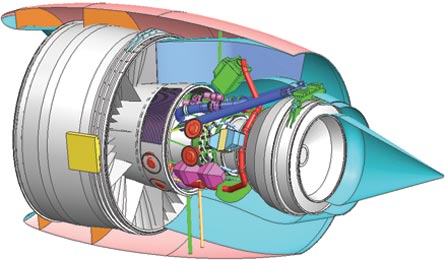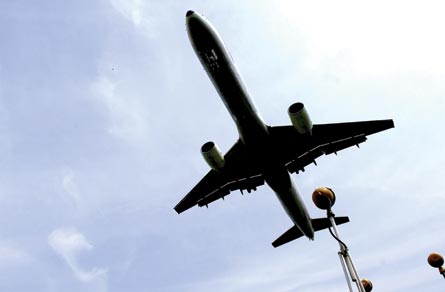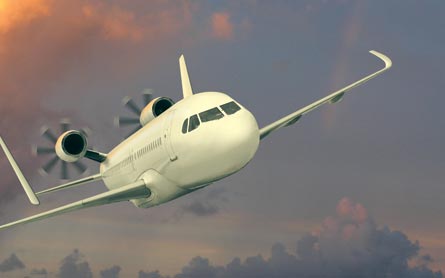Europe's €1.6 billion ($2.2 billion) Clean Skypublic-private research effort has set some ambitious targets for developing more environmentally friendly engine technologies under its Sustainable and Green Engines (SAGE) Integrated Technology Demonstrator programme. Engine manufacturers have one common goal: boost propulsive and thermal efficiency to reduce fuel burn and carbon dioxide emissions. But this involves designing a larger fan and a smaller core, which presents the unwanted issue of increased weight.
How this goal is achieved in the most lightweight way differs from manufacturer to manufacturer, but proposals have been selected for all five Clean Sky engine technology demonstrators, and those involved are optimistic that the targeted 2013-15 timeline for running the demonstrators will be met.
|
|---|
Clean Sky is a seven-year research effort which was launched in 2008 and is being funded equally between the European Commission and industry. It was established to develop advanced technologies aimed at helping the aviation industry meet the goals set by the Advisory Council for Aeronautical Research in Europe (ACARE), which include halving carbon dioxide emissions by 2020, as well as cutting nitrous oxide emissions by 80% and external noise by 50%. Clean Sky is built on six key research areas, of which Sustainable and Green Engines is one.
The SAGE initiative includes five engine technology subprojects run by various European manufacturers, which will culminate in five separate demonstrators scheduled to be run in the middle of this decade. SAGE 1 and 2 both focus on open rotor technology and are being run by Rolls-Royce and Snecma, respectively (see box p38). SAGE 3 is again being led by R-R and centres on its Advance3 large three-shaft turbofan, while SAGE 4 is being led by Germany's MTU Aero Engines and is based around the advanced geared turbofan it is developing in conjunction with Pratt & Whitney. Safran's Turbomeca division is in charge of SAGE 5 and is working on a turboshaft powerplant.
R-R's Advance3 programme is based on its Trent 1000 Environmentally Friendly Engine (EFE) core technology demonstrator. Advance3 aims to reduce fuel burn by 15-20% in the 2017/18 timeframe. The programme is aimed at widebody aircraft and offers a thrust range of 30,000-100,000lb (134-445kN). One of the main technologies behind Advance3 is lean burn combustion, which Rolls-Royce chief functional engineer, future programmes Richard Clough says gives a 50% reduction in nitrous oxide emissions over today's levels. The EFE demonstrator is near to test running and the programme will continue for the next three to four years. "There will be roughly one build a year and we'll build up the technology and add more and more with each build," says Clough.
 SAGE 3 is led by R-R and centres on its Advance3 large three-shaft turbofan |
|---|
SEPARATE DEMONSTRATIONS
Under the Clean Sky initiative, R-R's contribution will be to run its Advanced Low Pressure System (ALPS) demonstrator. While EFE and ALPS run together to form the Advance3 demo programme, Rolls-Royce has decided to "split them out and demonstrate them separately because it makes it easier and reduces the risk", says Clough. As with the EFE demonstrator, ALPS will go through a series of builds - again roughly one a year - to build up the technology. "It's not just the composite fan and casing, we're also looking at lightweight dressing. We plan to do several runs," says Clough.
"We're using the Trent 1000 engine as a donor, so we're adding new technology on top of the latest technology," explains R-R vice-president strategic marketing Robert Nuttall. "The real test comes when we integrate it with other technologies."
R-R is also ploughing ahead with work on its Advance2 two-shaft engine research programme, based on its E3E (efficiency, environment, economy) technology demonstrator core. Advance2 aims to deliver engines offering a 15-20% reduction in fuel burn by 2016-17. The Advance2 programme is aimed at medium and large corporate aircraft, regional aircraft with 70-130 seats and 140- to 200-seat narrowbodies. Its aim is to deliver new technologies that increase engine temperature, pressure ratio and component performance, in addition to a 25% increase in thrust-to-weight ratios.
An E3E demonstrator core was run for 40h at Stuttgart University's altitude test facility earlier this year. R-R is in the process of running high-pressure compressor, combustor and high-pressure turbine rig programmes to support the Core 3/2b demonstrator that was run in June. The company said earlier this year that further builds will be tested in 2011 and 2012 as it works towards a targeted 1,200 cycles of endurance testing in simulated maximum take-off conditions.
"The E3E programme is running this year and there will be one build a year going on for the next three to four years," says Clough. Adds Nuttall: "We're trying to make the bypass ratio larger and make the core as high temperature and high pressure as possible."
Propulsive efficiency (the ratio of energy converted to thrust) increases when the fan diameter is larger and the bypass ratio is higher. Thermal efficiency (how well the engine converts energy from combustion into kinetic energy in the turbines) is increased by boosting the pressure of the air entering the combustor, which means increasing the temperature. However, one downside of increasing the temperature is that it results in more nitrous oxide emissions, an issue manufacturers are seeking to address.
MTU's role in the Clean Sky initiative - along with partners Avio and Volvo - is to run a geared turbofan demonstrator, which it aims to carry out in 2013-14. Its plan is to advance the GTF currently in development for the regional market with Pratt & Whitney.
"We're looking to further increase propulsive efficiency by increasing the flow through the fan and decreasing fan pressurisation," says MTU senior vice-president technology Erich Steinhardt. "This requires development of advanced high speed, low pressure turbines with aggressive ducting and advanced reduction gear technologies, which are the core elements in our GTF SAGE 4 demonstrator. And of course we continue to explore ways to further reduce weight and will have to find new technologies which we will validate in the Clean Sky programme."
MTU has issued the first calls for proposals for technologies that will be introduced in the demonstrator. "We're in the middle of the process of getting feedback and we will award contracts early next year," says Steinhardt. MTU is looking to get small and medium-sized enterprises and universities involved in the project.
CUTTING CARBON DIOXIDE
Under its Clean Air Engine (CLAIRE) programme, MTU is also examining the option of developing a counter-rotating integrated shrouded propfan (CRISP) as part of its aim to develop an engine that emits 20% less carbon dioxide than current models by 2020-25. Steinhardt says the manufacturer is working with DLR and Pratt & Whitney to decide which option is the most promising to fulfil this objective: the advanced GTF or the CRISP. A decision will be made "in the next couple of years", although the advanced GTF looks to be the likely winner with Steinhardt describing it as "our favourite".
"It's difficult to say which one reduces carbon dioxide emissions the most - this is the subject of our studies," says Steinhardt, adding that the advanced GTF was chosen as the Clean Sky demonstrator over the CRISP because "if we were to go for CRISP it would take much more time and it would be far beyond the allocated budget".
The third step in MTU's CLAIRE programme is to develop an engine that reduces fuel burn by 30% "or maybe more" by 2035, says Steinhardt. To this end, it is working under the EU's 40-partner New Aero Engine Core Concepts (NEWAC) research programme to develop an intercooled recuperative engine, in which the heat exchangers are arranged in such a way that they use the remaining energy in the exhaust gas and feed it back.
"We are not waiting until 2035 - we're carrying out investigations into how to improve the thermal efficiency of engines," says Steinhardt, adding that improving component efficiencies is challenging because the current level is already high. "We're looking at further increasing the pressure ratio. Studies are going on and we're applying for EU funding."
MTU has tested two core configurations under the NEWAC programme and has achieved "some very nice results", says MTU head of innovation Joerg Sieber. "We could increase the thermal efficiency by up to 6%."
The Clean Sky initiative has come under intense pressure in the past for the high levels of bureaucracy associated with applying for research contracts. Co-ordinating project officer Giuseppe Pagnano insists that all issues pertaining to excessive red tape have now been "completely overcome", and that "the autonomy of Clean Sky allows the most efficient use of the available funding".
However, MTU's Steinhardt points out "there is not much less bureaucracy now than there was before, but we have made progress", and it is "too early to say it's improving".
"The current situation, after two years of activities, is not affected by lack of funding but instead by a different balance of resources involved in the programme, as a result of external factors like market, strategies, priorities and the evolution and maturity of the selected technologies," says Pagnano.
To date, 40 partners have been assigned grant agreements for the five projects. "SAGE topics are of high value so the total number in future calls will remain in this order of magnitude, probably up to 100," says Pagnano, adding that "all demonstrators are now confirmed in the 2013-15 period".
OPEN QUESTION
Unducted fan technology, more commonly known as open rotor, has been repeatedly billed as having the potential to shift the paradigm when it comes to reducing carbon dioxide emissions. But while engine giants such as Rolls-Royce and CFM International continue to promote open rotor and research ways of minimising the noise caused by the absence of an engine cowl, many questions remain over whether it will ever become a reality.
R-R vice-president of strategic marketing Robert Nuttall describes open rotor as "the only potential game-changer out there in engine technology", owing to its ability to cut fuel consumption by 30% compared with today's engines. "It allows a step change in reducing fuel burn but it's a novel engine - it has never been developed," says Nuttall.
R-R has been working on an open rotor demonstrator and has so far carried out three sets of windtunnel tests on Rig 145, a scale model one-sixth the size of a full-sized open rotor. High-speed tests were carried out to evaluate efficiency while low-speed tests looked at noise. "One of the big issues is that there is no cowl, so any noise escapes and can't be contained," says Nuttall. However, tests have shown that an open rotor engine "can be quieter than any engine flying today", says R-R.
The open rotor project will have two development phases, "one to prove the concept and one to test it", says Nuttall. R-R's aim is to design and build three open rotor engines "in the middle of the next decade", with a planned entry-into-service date between 2022 and 2025. The first two engines will be ground-tested in various configurations and the third will be a flight-test engine. The R-R open rotor is aimed at the 100- to 200-seat narrowbody market and has a thrust range of 20,000-35,000lb (89-156kN).
CFM International is working on its own open rotor programme, with the same planned entry-into-service date as the R-R project, and has been carrying out windtunnel tests over the last two-and-a-half years. The technology under development at CFM could reduce carbon dioxide emissions by 25% over today's models, says CFM manager of environmental affairs Francis Couillard, although the noise issue remains a key challenge.
|
|---|
"The European Union is looking for a 15dB improvement in noise, but open rotor gives a 5-10dB improvement," says Couillard. "We need to carry out more studies to understand noise." Nevertheless, CFM says it is "highly confident we could meet Stage 4 requirements if open rotor went ahead".
R-R and CFM co-founder Snecma are developing their open rotor technologies under the European Union's €1.6 billion ($2.2 billion) Clean Sky research project, which aims to run two open rotor demonstrators in 2015 as part of five planned demonstrators being developed under the Sustainable and Green Engines (SAGE) Integrated Technology Demonstrator project. Clean Sky's target is to see an in-flight open rotor demonstration on an Airbus A340-600 in 2015.
Open rotor's future is very much dependent on what Airbus and Boeing decide to do on the subject of single-aisle replacement. The technology's efficiency comes from its high bypass ratio, which requires a rotor with a diameter of 4.3m (14.1ft), considerably larger than the 1.78m diameter of a conventional turbofan. "Installation of the open rotor engine requires an all-new aircraft," says Nuttall, adding that "all airframers are interested in the concept" and R-R is "working closely" with both Airbus and Boeing. Couillard's view is that open rotor installation would require "modifications to narrowbodies, but not a new plane".
R-R earlier this year urged Airbus and Boeing to concentrate on bringing all-new single-aisle replacements to the market more quickly and to drop interim plans to introduce technology refreshes of existing narrowbodies. Both manufacturers say they aim to put forward a decision on future single-aisle aircraft at the end of this year, and this decision will largely determine whether open rotor eventually turns from fantasy to reality.
Source: Flight International


















